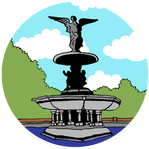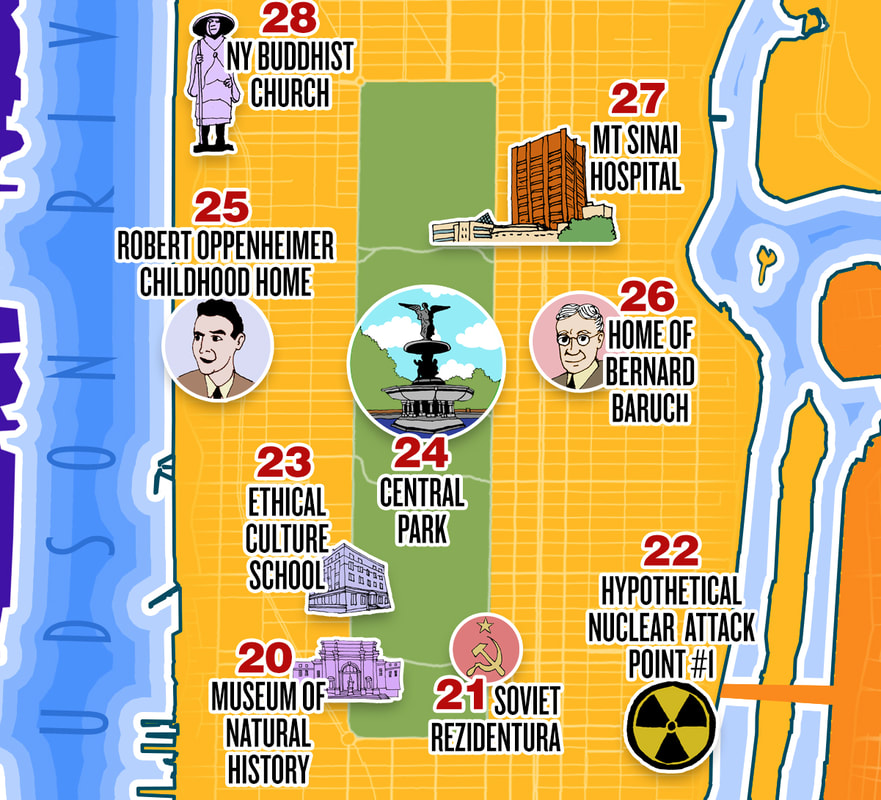Downtown Manhattan | Midtown Manhattan | Uptown Manhattan | Upper Manhattan & The Bronx | Brooklyn, Queens & Staten Island
|
An atomic energy exhibit opened at the AMERICAN MUSEUM OF NATURAL HISTORY (20) (200 Central Park West) on January 20, 1948. It was sponsored by the Brookhaven National Laboratory, which was owned by the Atomic Energy Commission.
Beginning in January of 1943, the Soviet Union established a “REZIDENTURA” (21) or espionage base, within the Soviet consulate at 7 East 61st Street. The mission was tasked with spying on the US atomic bomb program. For the first nationwide defense drill on June 14, 1954, three HYPOTHETICAL NUCLEAR ATTACK POINTS in NYC were selected as “ground zero.” The three sites were in Manhattan (22) (First Avenue & 57th Street), the Bronx, and Brooklyn. ROBERT OPPENHEIMER’S CHILDHOOD HOME (25) (155 Riverside Drive) was located in an earlier building at the site of 155 Riverside Drive. Oppenheimer, known as the Father of the Atomic Bomb, graduated from the ETHICAL CULTURE SCHOOL (23) (33 Central Park West) in 1921. CENTRAL PARK (24) (Bounded by Fifth Avenue, Central Park West, 59th & 110th Streets), 843 acres of the world’s most valuable real estate, set aside in the mid-19th century as a pastoral respite from the city, has been the scene of countless protest actions. On June 12, 1982, during the UN’s Second Special Session on Disarmament, over one million people crowded the streets and avenues of Manhattan in an attempt to assemble in Central Park. This “March and Rally to End the Arms Race” remains the largest antinuclear protest in US history. A building at the site of 1055 Fifth Avenue, since demolished, was once the HOME OF BERNARD BARUCH (26). Baruch, a powerful financier, was appointed by President Truman to deliver the US plan for the creation of the UN Atomic Energy Commission. In 1955, supported by the philanthropic vision of Saturday Review editor Norman Cousins, 25 atomic bomb survivors known as the Hiroshima Maidens were brought to MT. SINAI HOSPITAL (27) (1468 Madison Avenue). The group was organized by Rev. Kiyoshi Tanimoto, well-known in the US through John Hersey’s book Hiroshima, first published in The New Yorker in 1946. A decade after the bombings, doctors at Mt. Sinai performed reconstructive surgeries to provide mobility and ameliorate keloid scarring. One of the Maidens, Shigeko Sasamori, would often return to NYC to share her testimony with students through Youth Arts New York/Hibakusha Stories, which from 2008 to 2015 brought living witnesses from Hiroshima and Nagasaki to some 40,000 NYC youth. Standing outside the NEW YORK BUDDHIST CHURCH (28) (331 Riverside Drive) is a 15-foot bronze statue of Shinran Shonin, founder of the Jodo Shinshu sect of Japanese Buddhism. This statue originally stood outside a temple in Hiroshima, where it survived the bombing. It was relocated to New York in 1955 as a gift from Seiichi Hirose, an Osakan Buddhist. Red taints on the statue remain from damage sustained during the atomic attack. |
EXPLORE THE MAP
|
The Nuclear NYC Map was created by Kathleen Sullivan, Noah Diamond, Seth Shelden, and Matthew Bolton for NYCAN, incorporating research by Catherine Falzone. Map design by Noah Diamond.
© 2022 NYCAN. All rights reserved. |




